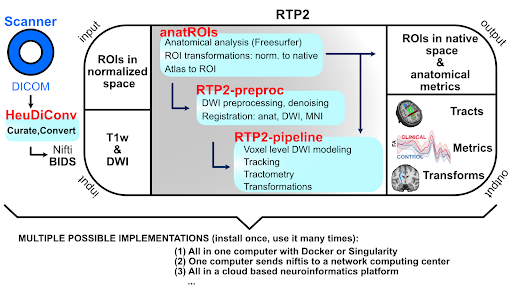RTP-pipeline
RTP2 pipeline
Reproducible Tract Profiles pipeline.
Reproducible Tract Profiles (RTP) comprises a set of methods to manage and analyze diffusion weighted imaging (DWI) data for reproducible tractography. The tools take MRI data from the scanner and process them through a series of analysis implemented as Docker containers that are integrated into a modern neuroinformatics platform (Flywheel). The platform guarantees that the entire pipeline can be re-executed, using the same data and computational parameters.

Three steps
Befor you run the three steps, first you should use HeuDiConv or any alternatives you would like to convert Dicom to Nifti in BIDS format for both anatomical and diffusion MRI data.
Once you have the Nifti files organized in BIDS format, there are three steps to run: 1) anatROIs to obtain ROIs from T1w image, 2) rtp-preproc to preprocess diffusion images, 3) rtp-pipeline to do streamline tracking and generate tractrometrics.
launchcontainers
We provide a series of python scripts that facilitate data organization and task submission for high performance computers:
RTP2 has three main containers corresponding to each step. Each container has its own repository and wiki, where you can find the introduction, installation and usage information:
anatROIs
RTP2-anatROIs processes the subject’s anatomical T1w nifti image to obtain ROIs that will later be used in tractography (RTP-preproc and RTP-pipeline). The input of this step is the subject’s T1w file (native space) and ROIs defined in MNI space; the output is a segmented T1w image and ROIs of interest in individual subject T1w space. AnatROIs provides many predefined ROIs, and it is possible to extend it in multiple ways.
rtp-preproc
RTP-preproc runs the mrTrix3 preprocessing pipeline in the diffussion data. It uses FSLs topup when the optional inverted phase encoding files are found, otherwise uses the eddy tool. It performs some other denoising steps, and it can normalize or align to acpc the data
rtp-pipeline
rtp-pipeline uses mrTrix3 to do the tracking, and obtains the metrics and the profiles. It quantifies the properties of white-matter tracts at the individual-subject level, and it offers the user high flexibility in terms of how to define white-matter tracts based on white-matter, subcortical and cortical ROIs, as well as the most representative tractrometrics (e.g., FA, RD, AD) and tract-similarity metrics (e.g., Dice,….)

